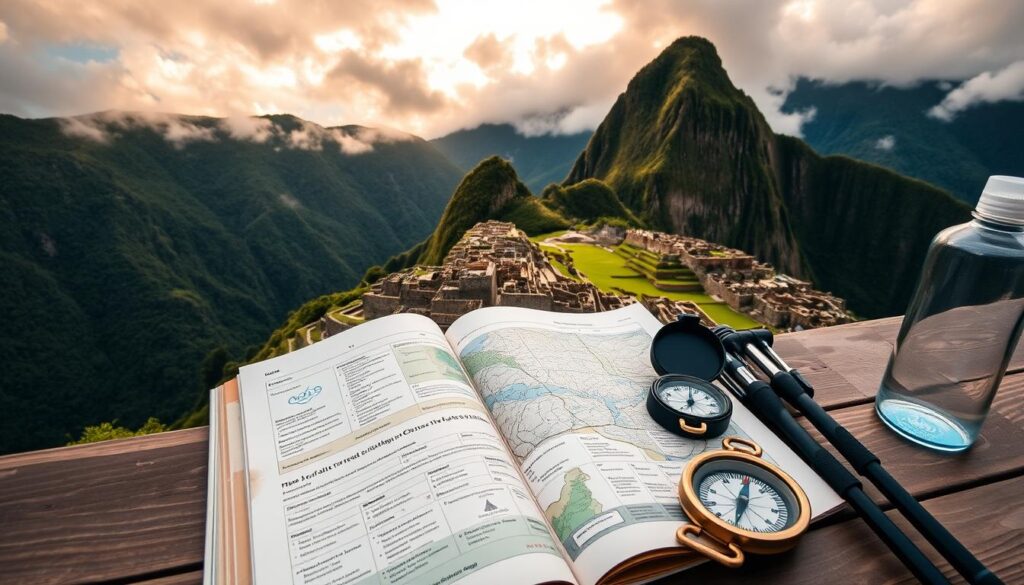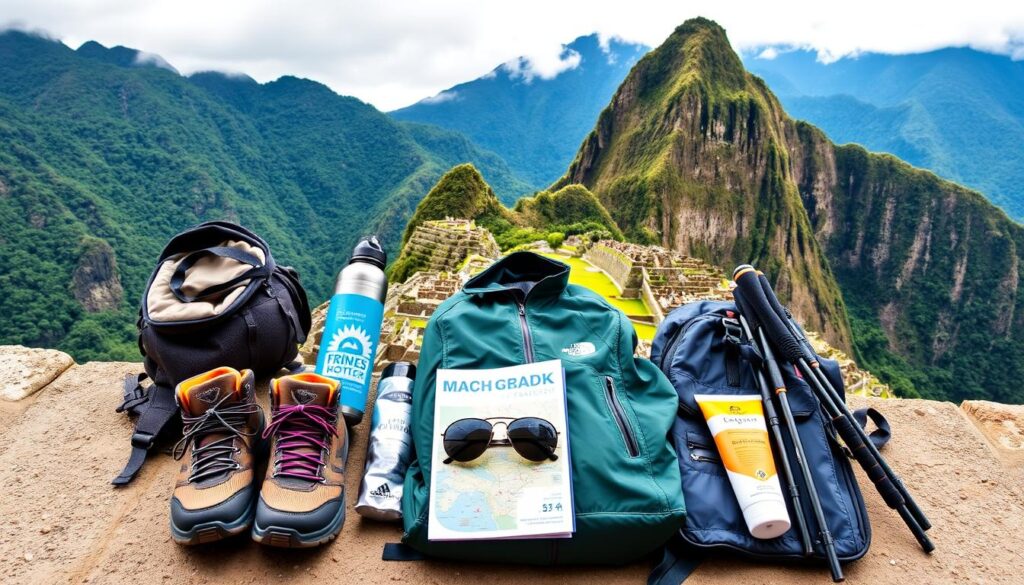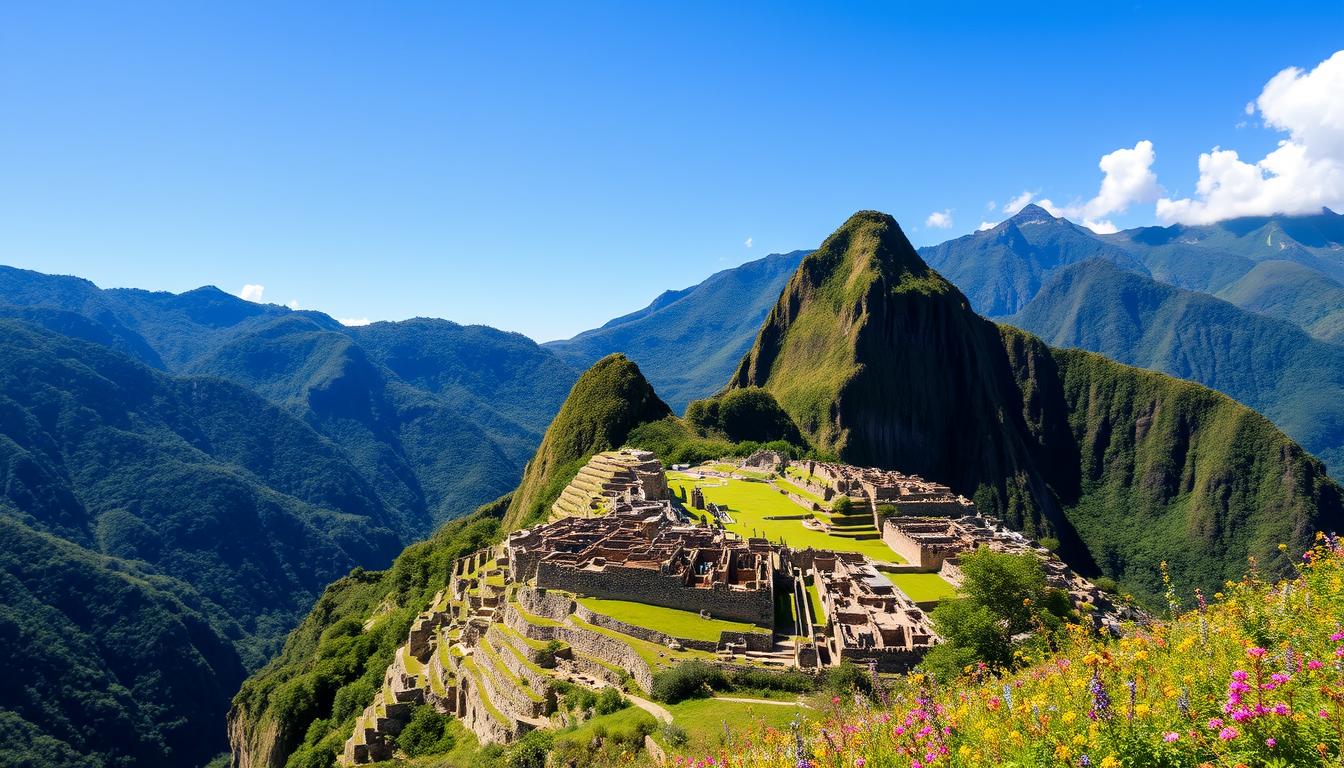Machu Picchu is a wonder of the Incas. It’s in the Peruvian Andes. It’s a mix of history and nature. Knowing when to go makes your trip special.
When is the best time to visit Machu Picchu? It depends on what you like. Do you want dry weather or fewer people? Are you hiking the Inca Trail? These things help pick the perfect time.
Machu Picchu is high up, at 2,430 meters. It’s big, covering 32,592 hectares. From April to October, the weather is dry and cool.
Key Takeaways
- Dry season (April to October) offers the best weather for visiting
- Peak tourist season is from June to August
- April and May provide a balance of good weather and fewer crowds
- The Inca Trail closes annually in February for maintenance
- Pack layers for varying temperatures and strong UV exposure
- Consider visiting during shoulder seasons for a less crowded experience
Understanding Machu Picchu: Location and Significance
Machu Picchu is a famous Inca ruins site. It shows off ancient engineering and cultural heritage. People from all over come to see its beauty and secrets.
Geographical Location in Peru
Machu Picchu is in a special place. It’s in the Andes Mountains of Peru, at 7,970 feet high. It looks over the Urubamba River Valley, with green forests and steep mountains around it.
Historical Background of the Inca Citadel
Machu Picchu was built in the 15th century. It was a royal home for Inca emperors. The buildings are amazing, blending with the mountains.
It was hidden from Spanish conquistadors. This kept its buildings safe for centuries.
UNESCO World Heritage Status
Machu Picchu is very important. It was named a UNESCO World Heritage site in 1983. This shows it’s a key and well-kept Inca ruins.
| Aspect | Details |
|---|---|
| Construction Period | 15th century |
| Altitude | 7,970 feet (2,430 meters) |
| UNESCO Recognition | 1983 |
| Daily Visitor Capacity | 5,600 (high season) |
Best Time to Travel to Machu Picchu
Choosing the right time to visit Machu Picchu is key. The ancient Inca citadel has something special all year. Each season has its own charm and challenges.
Peak Season (June to August)
The peak season is dry, from June to August. Visitors enjoy clear skies and comfy temps. June and July are busy, but August is a bit quieter.
Shoulder Season (April-May, September-October)
The shoulder season is great for good weather and fewer people. April and May are lush after the rains. September and October have nice hiking weather.
Low Season (November to March)
The off-season, from November to March, has more rain and warmer temps. Fewer tourists and lower prices are a plus. But, trails might close and paths can be muddy.
| Season | Months | Temperature Range | Crowd Level | Precipitation |
|---|---|---|---|---|
| Peak | June – August | 12°C – 24°C | High | Low |
| Shoulder | April-May, Sept-Oct | 12°C – 24°C | Moderate | Moderate |
| Low | November – March | 19°C – 21°C | Low | High |
To avoid crowds, visit early morning (6:00-7:00) or late afternoon (after 2:00 pm). The Festival of the Sun in late June is a cultural highlight.
Weather Patterns and Seasonal Changes
Knowing about Machu Picchu’s weather is key for a great trip. It has two main seasons, each with its own charm.
Dry Season Overview
The dry season is from April to October. Expect clear skies and little rain. Temperatures are nice, from 48°F to 79°F.
This is the busiest time, with lots of visitors. June, July, and August are the busiest months
Wet Season Characteristics
The rainy season is from November to March. It’s wet, but the greenery is stunning. Temperatures are mild, from 46°F to 72°F.
This season is less crowded. It offers a special view of Machu Picchu.
Monthly Temperature Variations
Machu Picchu’s weather changes all year. Here’s a look at the average temperatures and rain:
| Month | High (°F) | Low (°F) | Rainfall (mm) |
|---|---|---|---|
| January | 72 | 46 | 150 |
| April | 73 | 39 | 40 |
| July | 83 | 44 | 10 |
| October | 75 | 42 | 30 |
Machu Picchu’s weather can change fast. It’s in the Andes cloud forest. Always be ready for sudden weather changes.
Planning Your Journey to Machu Picchu
Planning a trip to Machu Picchu needs careful thought. The site is open all year, but July and August are the busiest months. Visiting in the shoulder season can make your trip better.

Start by booking your tickets. Adult tickets cost about $42, and students and kids pay $20. Daily limits are set, and Sundays are very busy because locals get in for free.
Think about how long it takes to get there. The train from Cusco to Aguas Calientes takes 3.5 hours each way. You can choose from Inca Rail, Peru Rail, or Belmond Hiram Bingham trains.
Don’t forget about altitude. Cusco is over 11,000 feet high, and Machu Picchu is just under 8,000. Spend a few days getting used to the high altitude to avoid sickness.
- Book entrance tickets in advance
- Plan for acclimatization
- Consider shoulder season for fewer crowds
- Allow sufficient time at the site (2 days recommended)
If you love adventure, there’s plenty to do. The Inca Trail needs a special permit. Other trails like Salkantay and Choquequirao are also great. But, the Inca Trail is closed in February for repairs.
Good planning makes your Machu Picchu visit unforgettable. Book early, follow the rules, and enjoy every moment of this amazing place.
Transportation Options and Access Routes
Planning your trip to Machu Picchu is key for a smooth ride. There are many ways to get there, each with its own charm.
Train Services from Cusco
The train is the most loved way to get to Machu Picchu. Trains leave from stations near Cusco. The time it takes to get to Aguas Calientes depends on where you start:
| Departure Station | Travel Time to Aguas Calientes |
|---|---|
| San Pedro | 4.5 hours |
| Poroy | 3.5 hours |
| Urubamba | 2.5 hours |
| Ollantaytambo | 1.5 hours |
Bus Options from Aguas Calientes
Shuttle buses from Aguas Calientes to Machu Picchu run often. The trip takes about 25-30 minutes. You’ll see stunning views along the way.
Hiking Trail Alternatives
For those who love hiking, there are great options:
- The classic Inca Trail: A 4-day trek covering 39 kilometers
- Salkantay Trek: Known for dramatic mountain scenery
- Lares Trek: Offers more cultural immersion
- Hike from Aguas Calientes: A steep 2-hour climb to the citadel
Choose your Machu Picchu transportation wisely. Book early, especially from May to September. Each path gives a special view of this Incan marvel.
Essential Packing Guide by Season

Creating a good Machu Picchu gear list is key for a comfy visit. The ancient site sits at 7,972 feet and the weather can change fast. You need to pack for these changes and the lack of services inside.
Think about the season you’ll visit. The dry season (April-November) needs different items than the wet season (November-March). Here’s a detailed guide to get you ready:
- Layered clothing (t-shirts, long-sleeved shirts, light jacket)
- Sturdy, comfortable hiking boots
- Rain gear (waterproof jacket and pants)
- Sun protection (hat, sunglasses, sunscreen)
- Small backpack (20-30 liters) for essentials
- Refillable water bottle
- Insect repellent
- Camera or smartphone for photos
- Portable charger
- Mini first aid kit
Remember, the terrain is rough and uneven, so skip sandals. Always carry a light rain jacket, as the weather can shift fast. Also, bring bug spray to keep away Amazon bugs. And, use a small backpack for your things, since there’s no help once you’re in.
“Prepare for all weather conditions. Machu Picchu can go from sunny to rainy in minutes.”
By using this Machu Picchu gear list, you’ll be set for an amazing adventure at this UNESCO World Heritage site.
Hiking and Trail Conditions Throughout the Year
Machu Picchu hiking trails are great all year. The best times are late April to early May and late September to early October. These months have fewer people and nice weather.
Inca Trail Availability
The Inca Trail is very popular. Only 500 permits are given out each day. Half go to guides and porters.
Book your spot 6 to 8 months early. This is especially true for Circuit 2. The trail is closed in February for repairs.
Alternative Trek Options
If the Inca Trail is full, try the Quarry Trail. It’s less crowded and open all year. This gives you more freedom to plan your trip.
Trail Difficulty Levels
Seasons change the trail’s conditions. The dry season (April to October) is best for hiking. The wet season (November to March) makes trails slippery and muddy.
January is the wettest month. June and July are much drier.
| Season | Rainfall | Trail Conditions | Crowd Level |
|---|---|---|---|
| Dry (Apr-Oct) | Low (8-41mm) | Optimal | High |
| Wet (Nov-Mar) | High (109-188mm) | Muddy, Slippery | Low |
| Shoulder (Apr-May, Sep-Oct) | Moderate | Good | Moderate |
Machu Picchu is open from 6:00 am to 5:00 pm every day. Visits usually last 2.5 to 4 hours. Plan well to enjoy your Incan adventure!
Avoiding Crowds and Peak Tourist Times
Machu Picchu gets very crowded, with over 3 million people visiting every year. To have a peaceful time, it’s important to plan when you go. The government limits visitors to 2,500 a day, with set times and a four-hour visit limit.
This means you need to plan well to avoid the crowds and get the best photos.
Best Times for Photography
Photographers should go early in the morning. Machu Picchu opens at 6 AM. This is a great time to take pictures before the fog comes.
Also, late afternoon, around 4 PM, is good. The light is nice, and most visitors leave by then. This leaves the site with a warm glow until it closes at 6 PM.
Quietest Periods to Visit
To avoid the crowds, visit in April-May or September-November. These times have good weather and fewer visitors. Don’t go during Holy Week, summer, or Peruvian Independence Day when it’s busier.
For a quiet visit, try December or early March. But, be ready for rain that might make it hard to see.
Sundays are busier because locals get in for free. So, plan your visit for other days. Staying overnight in Aguas Calientes lets you get there early. This way, you can explore and take photos without the crowds.


